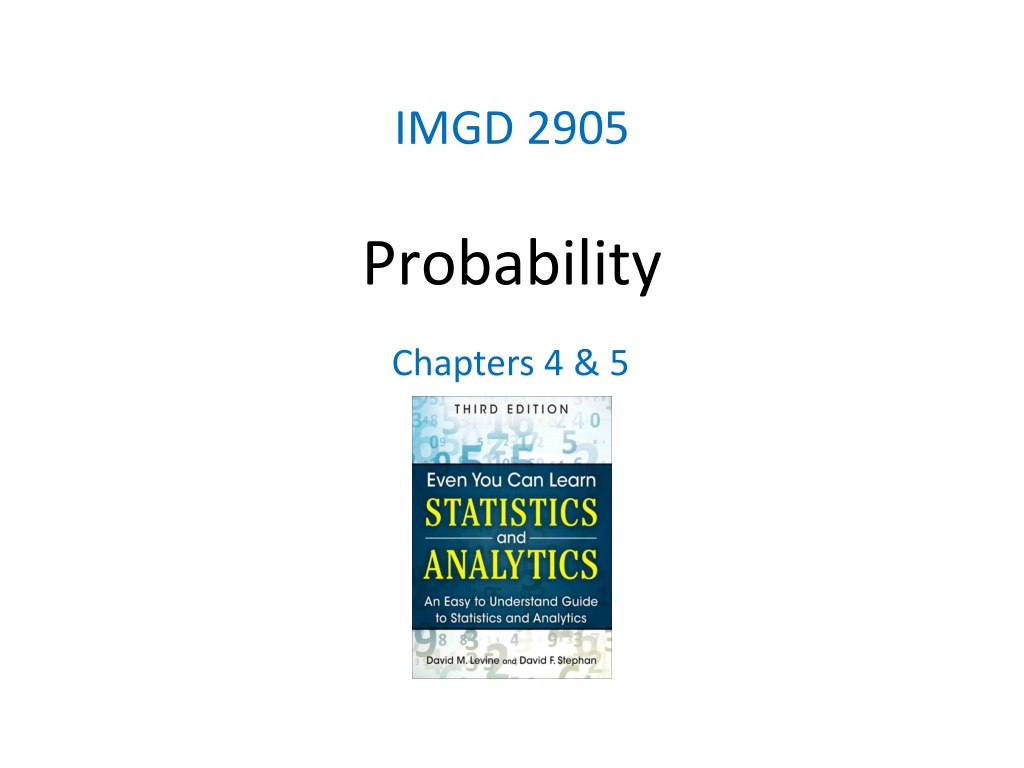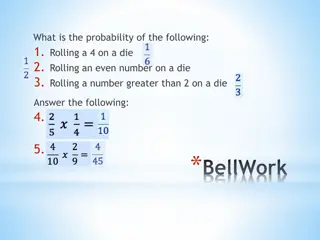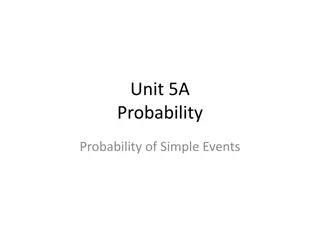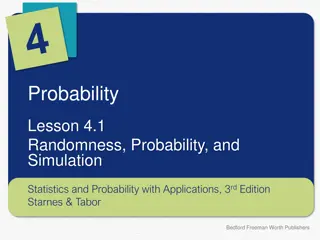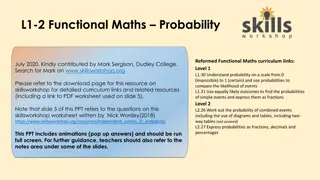Understanding Probability in Game Development
Exploring the significance of probability in game development, the content discusses basic probability concepts, examples of probabilities needed for game development, and specific scenarios like the likelihood of successful attacks, rare loot drops, enemy spawns, and time taken for actions. The article delves into elementary and compound events, exhaustive sets, and mutually exclusive events in probability calculations for gaming.
Uploaded on Sep 19, 2024 | 0 Views
Download Presentation

Please find below an Image/Link to download the presentation.
The content on the website is provided AS IS for your information and personal use only. It may not be sold, licensed, or shared on other websites without obtaining consent from the author. Download presentation by click this link. If you encounter any issues during the download, it is possible that the publisher has removed the file from their server.
E N D
Presentation Transcript
IMGD 2905 Probability Chapters 4 & 5
Overview Statistics important for game analysis Probability important for statistics So, understand some basic probability Also, probability useful for game development https://www.mathsisfun.com/data/images/probability -line.svg
Groupwork https://www.mathsisfun.com/data /images/probability-line.svg What are some examples of probabilities needed for game development? Provide a specific example Icebreaker, Groupwork, Questions https://web.cs.wpi.edu/~imgd2905/d22/groupwork/5- probabilities/handout.html
Overview Probabilities for game development? Examples? Statistics important for game analysis Probability important for statistics So, understand some basic probability Also, probability itself useful for game development
Overview Probabilities for game development? Probability attack will succeed Probability loot from enemy contains rare item Probability enemy spawns at particular time Probability action (e.g., building a castle) takes particular amount of time Probability players at server Statistics important for game analysis Probability important for statistics So, understand some basic probability Also, probability itself useful for game development
Outline Introduction Probability Probability Distributions (done) (next)
Probability Definitions (1 of 3) Probability way of assigning numbers to outcomes to express likelihood of event Event outcome of experiment or observation Elementary simplest type for given experiment. independent Joint/Compound more than one elementary Roll die (d6) and get 6 elementary event Roll die (d6) and get even number compound event, consists of elementary events 2, 4, and 6 Pick card from standard deck and get queen of spades elementary event Pick card from standard deck and get face card compound event Observe players logging in to MMO server and see if two people log in less than 15 minutes apart compound event We ll treat/compute probabilities of elementary versus compound separately https://cdn.kastatic.org/googleusercontent/Z0TuLq2KolavsrfDXSbLqi0S- wnlCrC13cKGG68wK9ljrTiXzRqvfq7IpWNzcwgzlpEOI8YmMafp4K4zO0sanvXu
Probability Definitions (2 of 3) Exhaustive set of events set of all possible outcomes of experiment/observation Mutually exclusive sets of events elementary events that do not overlap Roll d6: Events: 1, 2 not exhaustive, mutually exclusive Roll d6: Events: 1, 2, 3, 4, 5, 6 exhaustive, mutually exclusive Roll d6: Events: get even number, get number divisible by 3, get a 1 or get a 5 exhaustive, but overlap Observe logins: time between arrivals <10 seconds, 10+ and <15 seconds inclusive, or 15+ seconds exhaustive, mutually exclusive Observe logins: time between arrivals <10 seconds, 10+ and <15 seconds inclusive, or 10+ seconds exhaustive, but overlap
Probability Definitions (3 of 3) Probability likelihood of event to occur, ratio of favorable cases to all cases Set of rules that probabilities must follow Probabilities must be between 0 and 1 (but often written/said as percent) Probabilities of set of exhaustive, mutually exclusive events must add up to 1 e.g., d6: events 1, 2, 3, 4, 5, 6. Probability of 1/6th to each, sum of P(1) + P(2) + P(3) + P(4) + P(5) + P(6) = 1 legal set of probabilities e.g., d6: events 1, 2, 3, 4, 5, 6. Probability of to roll 1, to roll 2, and 0 to all the others sum of P(1) + + P(6) = 0.5 + 0.5 + 0 + 0 = 1 Also legal set of probabilities Not how honest d6 s behave in real life! https://goo.gl/iy3YGr Q: how to assign probabilities?
How to Assign Probabilities? http://static1.squarespace.com/static/5a14961cf14aa1f245bc39 42/5a1c5e8d8165f542d6db3b0e/5acecc7f03ce64b9a46d99c6/1 529981982981/Michael+Jordan+%2833%29.png?format=1500w https://newvitruvian.com/images/marbles-clipart-bag-marble-4.png Q: how to assign probabilities?
Assigning Probabilities Classical (by theory) In some cases, exhaustive, mutually exclusive outcomes equally likely assign each outcome probability of 1/n e.g., d6: 1/6, Coin: prob heads , tails , Cards: pick Ace 1/13 Empirically (by observation) Obtain data through measuring/observing e.g., Watch how often people play PUBG in FL222 versus some other game. Say, 30% PUBG. Assign that as probability Subjective (by hunch) Based on expert opinion or other subjective method e.g., eSports writer says probability Fnatic (European LoL team) will win World Championship is 25%
Rules About Probabilities (1 of 2) Complement: A an event. Event Probability A does not occur called complement of A, denoted A P(A ) = 1 - P(A) Why? e.g., d6: P(6) = 1/6, complement is P(6 ) and probability of not 6 is 1-1/6, or 5/6. Note: Value often denoted p, complement is q Mutually exclusive:Have no simple outcomes in common can t both occur in same experiment P(A or B) = P(A) + P(B) Probability either occurs e.g., d6: P(3 or 6) = P(3) + P(6) = 1/6 + 1/6 = 2/6
Rules About Probabilities (2 of 2) Independent: Probability that one occurs doesn t affect probability that other occurs e.g., 2d6: A= die 1 get 5, B= die 2 gets 6. Independent, since result of one roll doesn t affect roll of other Probability both occur e.g., 2d6: prob of snake eyes is P(1) x P(1) = 1/6 x 1/6 = 1/36 Not independent: One occurs affects probability that other occurs Probability both occur Where P(B | A) means prob B given A happened e.g., PUBG chance of getting top 10 is 10%. Chance of using only stock gun 50%. You might think that: P(top 10) x P(stock) = 0.10 x 0.50 = 0.05 But likely not independent. P(top | stock) < 5%. So, need non- independent formula P(top) * P(top | stock) P(A and B) = P(A) x P(B) P(A and B) = P(A) x P(B | A) (Card example next slide)
Probability Example Probability drawing King?
Probability Example Probability drawing King? P(K) = Draw, put back. Now?
Probability Example Probability drawing King? P(K) = Draw, put back. Now? P(K) = Probability not King?
Probability Example Probability drawing King? P(K) = Draw, put back. Now? P(K) = Probability not King? P(K ) = 1-P(K) = Draw, put back. 2 Kings?
Probability Example Draw. King or Queen? Probability drawing King? P(K) = Draw, put back. Now? P(K) = Probability not King? P(K ) = 1-P(K) = Draw, put back. Draw. 2 Kings? P(K) x P(K) = x = 1/16
Probability Example Draw. King or Queen? P(K or Q) = P(K) + P(Q) = + = Probability drawing King? P(K) = Draw, put back. Now? P(K) = Probability not King? P(K ) = 1-P(K) = Draw, put back. Draw. 2 Kings? P(K) x P(K) = x = 1/16
Probability Example Draw. King or Queen? P(K or Q) = P(K) + P(Q) = + = Draw, put back. Draw. Not King either card? Probability drawing King? P(K) = Draw, put back. Now? P(K) = Probability not King? P(K ) = 1-P(K) = Draw, put back. Draw. 2 Kings? P(K) x P(K) = x = 1/16
Probability Example Draw. King or Queen? P(K or Q) = P(K) + P(Q) = + = Draw, put back. Draw. Not King either card? P(K ) x P(K ) = x = 9/16 Draw, don t put back. Draw. Not King either card? Probability drawing King? P(K) = Draw, put back. Now? P(K) = Probability not King? P(K ) = 1-P(K) = Draw, put back. Draw. 2 Kings? P(K) x P(K) = x = 1/16
Probability Example Draw. King or Queen? P(K or Q) = P(K) + P(Q) = + = Draw, put back. Draw. Not King either card? P(K ) x P(K ) = x = 9/16 Draw, don t put back. Draw. Not King either card? P(K ) x P(K | K ) = x (1-1/3) = x 2/3 = 6/12 = Draw, don t put back. Draw. King 2nd card? Probability drawing King? P(K) = Draw, put back. Now? P(K) = Probability not King? P(K ) = 1-P(K) = Draw, put back. 2 Kings? P(K) x P(K) = x = 1/16
Probability Example Draw. King or Queen? P(K or Q) = P(K) + P(Q) = + = Draw, put back. Draw. Not King either card? P(K ) x P(K ) = x = 9/16 Draw, don t put back. Draw. Not King either card? P(K ) x P(K | K ) = x (1-1/3) = x 2/3 = 6/12 = Draw, don t put back. Draw. King 2nd card? P(K ) x P(K | K ) = x = 3/12 = Probability drawing King? P(K) = Draw, put back. Now? P(K) = Probability not King? P(K ) = 1-P(K) = Draw, put back. 2 Kings? P(K) x P(K) = x = 1/16
Outline Intro Probability Probability Distributions (done) (done) (next)
Probability Distributions Probability distribution values and likelihood (expected value) that random variable can take Why? If can model mathematically, can use to predict occurrences e.g., probability slot machine pays out on given day e.g., probability game server hosts player today e.g., probability certain game mode is chosen by player Also, some statistical techniques for some distributions only https://goo.gl/jqomFI Types discussed: Uniform (discrete) Binomial (discrete) Poisson (discrete) Normal (continuous) Remember empirical rule? What distribution did it apply to?
Uniform Distribution So what? Can use known formulas
Uniform Distribution So what? Can use known formulas Mean = (1 + 6) / 2 = 3.5 Variance = ((6 1 + 1)2 1)/12 = 2.9 Std Dev = sqrt(Variance) = 1.7 Note mean is also the expected value (if you did a lot of trials, would be average result)
Binomial Distribution Example (1 of 3) How to assign probabilities? Suppose toss 3 coins Random variable X = number of heads Want to know probability of exactly 2 heads P(X=2) = ?
Binomial Distribution Example (1 of 3) How to assign probabilities? Could measure (empirical) Q: how? Could use hunch (subjective) Q: what do you think? Could use theory (classical) Math using our probability rules (not shown) Enumerate (next) Suppose toss 3 coins Random variable X = number of heads Want to know probability of exactly 2 heads P(X=2) = ?
Binomial Distribution Example (2 of 3) http://web.mnstate.edu/peil/MDEV102/U3/S25/Cartesian3.PNG All equally likely (p is 1/8 for each) P(HHT) + P(HTH) + P(THH) = 3/8 Can draw histogram of number of heads
Binomial Distribution Example (3 of 3) http://www.mathnstuff.com/math/spoken/here/2class/90/binom2.gif ( Pascal's Triangle) These are all binomial distributions
Binomial Distribution (1 of 2) In general, any number of trials (n) & any probability of successful outcome (p) (e.g., heads) Characteristics of experiment that gives random number with binomial distribution: Experiment of n identical trials. Trials are independent Each trial only two possible outcomes, Success or Fail Probability of Success each trial is same, denoted p Random variable of interest (X) is number of Successes in n trials http://www.vassarstats.net/textbook/f0603.gif
Binomial Distribution (2 of 2) So what? Can use known formulas http://www.s-cool.co.uk/gifs/a-mat-sdisc-dia08.gif Excel: binom.dist() binom.dist(x,trials,prob,cumulative) 2 heads, 3 flips, coin, discrete =binom.dist(2, 3, 0.5, FALSE) =0.375 (i.e., 3/8) http://www.s-cool.co.uk/gifs/a-mat-sdisc-dia12.gif If true ?
Binomial Distribution Example Each row is like a coin flip right = heads left = tails Bottom axis is number of heads Gives and empirical way to estimate P(X) bin(X) sum(bin(0) + bin(1) + ) https://www.mathsisfun.com/data/quincunx.html
Poisson Distribution Distribution of probability of x events occurring in certain interval (broken into units) Interval can be time, area, volume, distance e.g., number of players arriving at server lobby in 5- minute period between noon-1pm Requires 1. Probability of event same for all time units 2. Number of events in one time unit independent of number of events in any other time unit 3. Events occur singly (not simultaneously). In other words, as interval unit gets smaller, probability of two events occurring approaches 0
Poisson Distributions? Not Poisson Number of people arriving at restaurant during dinner hour People frequently arrive in groups Number of students registering for course in Workday per hour on first day of registration Prob not equal most register in first few hours Not independent if too many register early, system crashes Could Be Poisson Number of groups arriving at restaurant during dinner hour Number of logins to MMO during prime time Number of defects (bugs) per 100 lines of code People arriving at cash register (if they shop individually) https://tinyurl.com/3xbaht9c Phrase people use is random arrivals Poisson?
Poisson Distribution Distribution of probability of x events occurring in certain interval https://tinyurl.com/2ad6fewt http://www.dummies.com/education/math/business-statistics/how-to-compute-poisson-probabilities/
Poisson Distribution Example 1. Number of games student plays per day averages 1 per day 2. Number of games played per day independent of all other days 3. Can only play one game at a time What s probability of playing 2 games tomorrow? In this case, the value of = 1, want P(X=2)
Current Poisson Distribution Example https://stattrek.com/online-calculator/poisson.aspx New England city Average new COVID-19 cases 50/day Local hospital has 60 free beds What is the probability more than 60 in one day? Q: How do we get greater than 60? = ??? P(0) + P(1) + + P(60) P( 60) P(>60) = 1 = P( 60)
Current Poisson Distribution Example https://stattrek.com/online-calculator/poisson.aspx New England city Average new COVID-19 cases 50/day Local hospital has 60 free beds What is the probability more than 60 in one day? 60 Q: How do we get greater than 60? = ??? P(0) + P(1) + + P(60) P( 60) P(>60) = 1 = P( 60) 50 60
Current Poisson Distribution Example https://stattrek.com/online-calculator/poisson.aspx https://stattrek.com/online-calculator/poisson.aspx New England city Average new COVID-19 cases 50/day Local hospital has 60 free beds What is the probability more than 60 in one day? 60 Q: How do we get greater than 60? = ??? P(0) + P(1) + + P(60) P( 60) P(>60) = 1 = P( 60) 50 60
Current Poisson Distribution Example https://stattrek.com/online-calculator/poisson.aspx New England city Average new COVID-19 cases 50/day Local hospital has 60 free beds What is the probability more than 60 in one day? 60 Q: How do we get greater than 60? = 0.02 P(0) + P(1) + + P(60) P( 60) P(>60) = 1 = P( 60) 50 60
Current Poisson Distribution Example https://stattrek.com/online-calculator/poisson.aspx New England city Average new COVID-19 cases 50/day Local hospital has 60 free beds What is the probability more than 60 in one day? 60 Q: How do we get greater than 60? = 0.02 P(0) + P(1) + + P(60) P( 60) P(>60) = 1 - P( 60) 50 60
Poisson Distribution So what? Known formulas https://www.researchgate.net/publication/317746840/figure/fig1/AS:779409749 471250@1562837173902/The-Poisson-distribution-probability-function.gif Mean = Variance = Std Dev = sqrt ( ) Excel: poisson.dist() poisson.dist(x,mean,cumulative) mean 50 per day, 60 beds, chance > 60? = 1 - POISSON.DIST(60, 50, TRUE) =0.07216 e.g., Games may want to know likelihood of 1.5x average people arriving at server
Expected Value Formulation Expected value of discrete random variable is value you d expect after many experimental trials. i.e., mean value of population Value: x1 x2 Probability: P(x1)P(x2)P(x3) Compute by multiplying each value by probability and summing x3 xn P(xn) x = E(X) = x1P(x1) + x2P(x2) + + xnP(xn) = xiP(xi)
Expected Value Example Gambling Game Pay $3 to enter Roll 1d6 6? Get $7 1-5? Get $1 What is expected payoff? Expected net? Outcome Payoff 1-5 6 P(x) xP(x) 5/6 $5/6 1/6 $7/6 $1 $7 E(x) = $5/6 + $7/6 = $12/6 = $2 E(net) = E(x) - $3 = $2 - $3 = 0
Expected Value Example Gambling Game Pay $3 to enter Roll 1d6 6? Get $7 1-5? Get $1 What is expected payoff? Expected net? OutcomePayoff 1-5 6 P(x) xP(x) 5/6$5/6 1/6$7/6 $1 $7 E(X) = $5/6 + $7/6 = $12/6 = $2 E(net) = E(x) - $3 = $2 - $3 = 0
Expected Value Example Gambling Game Pay $3 to enter Roll 1d6 6? Get $7 1-5? Get $1 What is expected payoff? Expected net? Outcome Payoff 1-5 6 P(x) xP(x) 5/6 $5/6 1/6 $7/6 $1 $7 E(X) = $5/6 + $7/6 = $12/6 = $2 E(net) = E(X) - $3 = $2 - $3 = $-1
Expected Value Example Gambling Game Pay $3 to enter Roll 1d6 6? Get $7 1-5? Get $1 What is expected payoff? Expected net? OutcomePayoff 1-5 6 P(x) xP(x) 5/6$5/6 1/6$7/6 $1 $7 E(X) = $5/6 + $7/6 = $12/6 = $2 E(net) = E(X) - $3 = $2 - $3 = $-1
Outline Intro Probability Probability Distributions Discrete (done) (done) (done) So far random variable could take only discrete set of values Q: What does that mean? Q: What other distributions might we consider?
